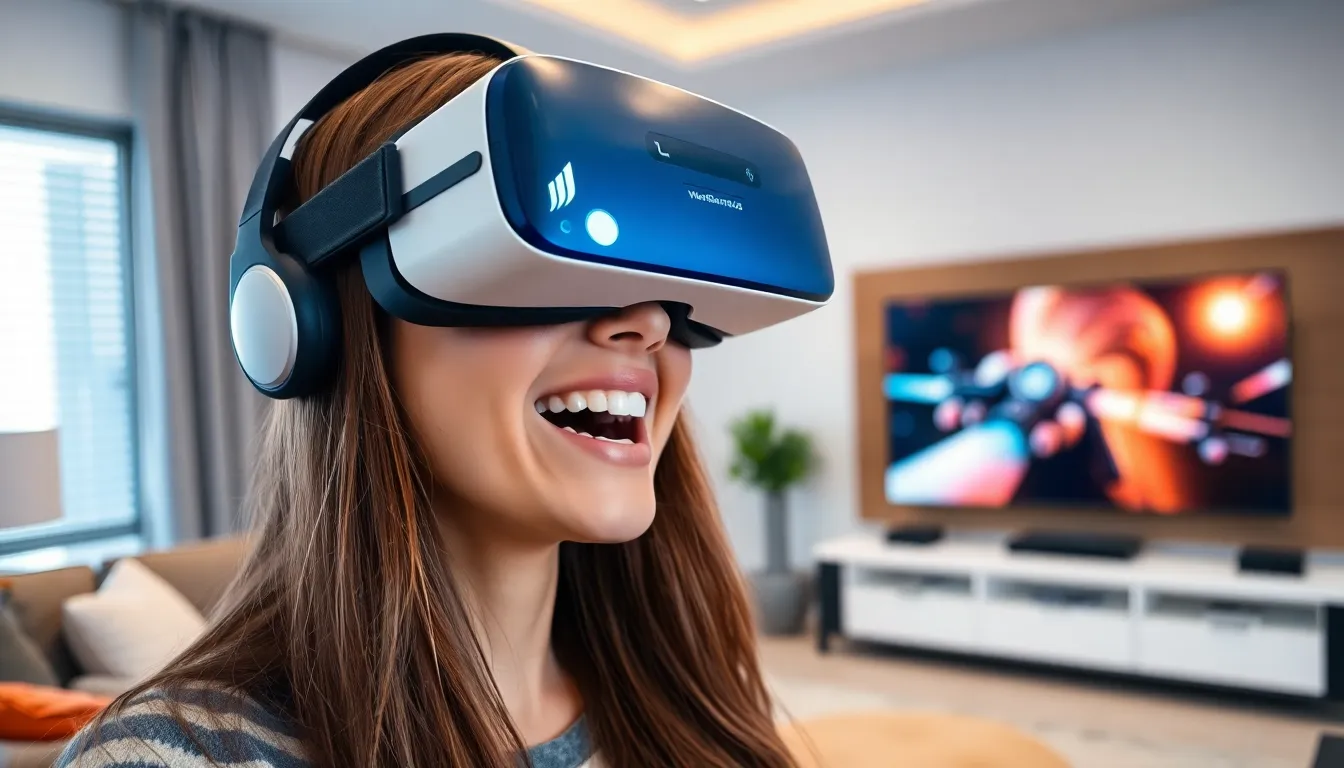In a world where reality often feels a bit too mundane, augmented reality (AR) and virtual reality (VR) swoop in like superheroes, ready to transform the everyday into the extraordinary. Imagine slipping on a headset and finding yourself in a galaxy far, far away or simply pointing your phone at a wall and watching it come alive with art and information. It’s like magic, but with a lot more coding and a lot less rabbit-in-a-hat.
As technology evolves, so does the debate over which immersive experience reigns supreme. Is it the enchanting allure of VR, whisking users away to entirely new worlds, or the practical charm of AR, enhancing reality without the need for a time machine? Buckle up as we dive into this digital duel, exploring the quirks and perks of both AR and VR to see which one truly deserves the crown.
Table of Contents
ToggleOverview of AR and VR
Augmented reality (AR) and virtual reality (VR) represent two distinct technologies with unique applications. Both are shaping the future of digital interaction.
Definition of Augmented Reality (AR)
Augmented reality (AR) seamlessly integrates digital elements into the real world. This technology enhances users’ experiences by overlaying images, data, or sounds onto their physical environment. For example, mobile applications like Pokémon GO utilize AR to blend virtual creatures with real-world surroundings. By using smartphones or AR glasses, users can interact with both physical and virtual objects. AR finds applications in industries such as retail, education, and healthcare, where it boosts engagement and practical utility. Its ability to enrich real-world experiences distinguishes AR in the technological landscape.
Definition of Virtual Reality (VR)
Virtual reality (VR) immerses users in a fully virtual environment. This technology creates simulations that transport individuals to entirely different worlds, often using headsets and motion tracking. Game developers leverage VR to create interactive experiences like the popular Beat Saber, where players engage in rhythm-based challenges. Education also benefits from VR, as simulated environments allow students to explore complex subjects. Such immersive experiences encourage deeper learning and understanding. VR’s capacity to transport users into alternate realities sets it apart from other technologies, creating opportunities for innovative application across sectors.
Key Differences Between AR and VR

Augmented reality (AR) and virtual reality (VR) exhibit distinct characteristics that impact user experiences and technological demands. Understanding these differences is crucial for anyone exploring these immersive technologies.
User Experience
AR enhances the real world, allowing users to see and interact with digital elements overlaying their physical surroundings. Examples include educational apps that project 3D models in classrooms. In contrast, VR immerses users entirely within a simulated environment, shutting out the real world. Gaming experiences like Beat Saber exemplify this complete immersion, engaging users in interactive scenarios that feel wholly separate from their reality. Users seeking a blend of physical and digital should prefer AR, while those craving full escape into a virtual realm will lean toward VR.
Technology Requirements
AR relies on smartphones or tablets equipped with cameras and sensors to blend digital content with the physical world. This accessibility makes AR widely usable, requiring minimal hardware. VR, however, demands specialized headsets and controllers, creating a more immersive setup. High-performance PCs or gaming consoles often support VR devices, ensuring that users experience rich graphics and smooth interactions. The choice between AR and VR not only involves user preference but also necessitates consideration of available technology and desired experiences.
Applications of AR and VR
AR and VR technologies find extensive applications across many fields, enhancing experiences in unique ways.
AR in Various Industries
AR technology plays a significant role in numerous sectors. In retail, customers can visualize products in their own spaces before purchasing. Education benefits from AR by allowing students to interact with 3D models, making complex concepts easier to grasp. Healthcare utilizes AR for surgical training, providing lifelike simulations that improve surgical skills. Real estate professionals showcase properties through virtual tours, helping clients navigate choices more effectively.
VR in Various Industries
VR also transforms various industries with immersive experiences. In gaming, it creates engaging environments that transport players into new worlds, offering unparalleled entertainment. Educational institutions adopt VR for virtual field trips, expanding learning opportunities beyond the classroom. The healthcare sector uses VR for patient therapy, helping individuals confront fears in a controlled setting. Additionally, corporate training employs VR to simulate real-world scenarios, improving employee skills in a risk-free environment.
Advantages and Disadvantages of AR and VR
Augmented reality (AR) and virtual reality (VR) each offer unique benefits and drawbacks that impact user engagement and application effectiveness.
Pros of Augmented Reality
AR enhances real-world experiences. Users access interactive elements without disconnecting from their surroundings. This technology enables applications in education, allowing students to visualize complex concepts. Retailers benefit from AR by offering virtual try-ons of clothing or makeup, leading to informed purchasing decisions. Low entry barriers exist, as most smartphones support AR apps. The integration of digital information into daily life fosters creativity, enhancing real-time decision making.
Cons of Augmented Reality
Despite its benefits, AR presents challenges. Privacy concerns arise with the collection of user data. Limited immersion often leads to distractions, impacting user engagement. Performance depends on the quality of the device used, affecting app functionality. Some users might experience difficulties in navigating AR due to unfamiliarity. Additionally, technical issues like lag can diminish the experience, frustrating users who seek seamless interactions.
Pros of Virtual Reality
VR offers immersive experiences that transport users into fully digital environments. It facilitates effective training simulations in various fields, such as healthcare and aviation, allowing users to practice in risk-free settings. Users engage deeply with content, resulting in heightened focus and retention. The technology creates unique opportunities for social interaction in virtual spaces. Gaming benefits tremendously, transforming traditional gameplay into captivating adventures.
Cons of Virtual Reality
Nonetheless, VR also has drawbacks. High costs associated with VR headsets and systems limit accessibility for some users. Motion sickness can occur due to prolonged use, affecting overall enjoyment. Users often feel isolated from reality, reducing social interactions in physical spaces. Technical issues such as tracking errors can hinder the experience, creating frustration. Lastly, content availability may lag behind demand, limiting user options in the market.
Future of AR and VR
Emerging technologies continue to shape the landscape of augmented reality (AR) and virtual reality (VR). Innovations in hardware and software signal significant advancements on the horizon.
Trends to Watch
Increased investment in AR and VR technologies attracts major companies and startups. Companies like Microsoft and Facebook are advancing their AR and VR initiatives, enhancing user experiences in various applications. Spatial computing, which blends AR and VR for more interactive experiences, surfaces as a noteworthy trend. The rise of 5G networks enables smoother, more responsive AR applications. Additionally, wearable technology, such as smart glasses, is expected to gain traction, further blurring the lines between digital and physical realms.
Potential Impact on Society
AR and VR promise to revolutionize how individuals interact with the world. These technologies enhance remote collaboration, allowing teams to work together seamlessly from different locations. Educational settings benefit from immersive learning experiences, enabling students to engage with complex subjects more effectively. In healthcare, VR therapy is showing potential for treating conditions like PTSD and anxiety. Overall, the societal impact of AR and VR could lead to more inclusive and accessible experiences across various fields.
Both AR and VR hold immense potential to reshape how people interact with technology and each other. As they continue to evolve the distinctions between the two will become increasingly important. AR’s ability to enhance reality offers practical applications that can improve everyday tasks while VR’s immersive experiences provide unique opportunities for entertainment and training.
The future of these technologies is bright with ongoing advancements promising to enhance user experiences. As industries adopt AR and VR solutions the impact on education healthcare and entertainment will be profound. Embracing these innovations will lead to a more connected and interactive world where digital and physical realities coexist harmoniously.









